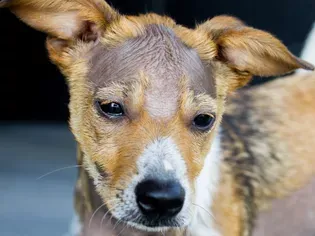Alopecia in Dogs
Updated on 04/26/24

Alopecia in Dogs: The Ultimate Guide to Causes, Symptoms, and Treatments
If you've noticed your furry friend losing hair in patches or even going bald, you're not alone. Alopecia, the medical term for hair loss, is a common condition in dogs. While it can be alarming, it's important to know that alopecia is often treatable.
In this comprehensive guide, we'll explore the causes of alopecia in dogs, the different symptoms to watch for, and the latest treatments available. Whether you're a concerned pet owner or a veterinary professional, this article will provide you with the knowledge and resources you need to help your dog regain its healthy coat.
Causes of Alopecia in Dogs
Alopecia can affect dogs of all ages, breeds, and sizes. There are numerous underlying causes, which can be classified into three main categories:
1. Non-inflammatory Alopecia
- Genetics: Some dog breeds are genetically predisposed to hair loss, such as the Doberman Pinscher, Chihuahua, and Poodle.
- Hormonal Imbalances: Alopecia can be a symptom of hormonal disorders, such as hypothyroidism, Cushing's disease, and sex hormone imbalances.
- Nutritional Deficiencies: A lack of essential nutrients, such as vitamins A, B, and E, can lead to hair loss.
- Drug Reactions: Certain medications can have side effects that include alopecia.
2. Inflammatory Alopecia
- Allergies: Food allergies, contact allergies, and flea allergies can cause intense itching and scratching, which can lead to hair loss.
- Infections: Bacterial and fungal infections can attack the hair follicles, causing hair to break off or fall out.
- Autoimmune Disorders: Autoimmune conditions, such as lupus and pemphigus, can cause the body to attack its own hair follicles.
3. Other Causes
- Stress: Extreme stress can trigger hair loss in some dogs.
- Parasites: Mites, lice, and ringworms can feed on the hair and cause hair loss.
- Skin Trauma: Injuries, such as burns or wounds, can damage hair follicles and lead to alopecia.
Symptoms of Alopecia in Dogs
The symptoms of alopecia in dogs can vary depending on the underlying cause. Some common signs include:
- Patchy hair loss: Hair loss can occur on any part of the body, but it's often most noticeable on the face, trunk, or limbs.
- Bald patches: In severe cases, hair loss can progress to complete baldness.
- Itching: Dogs with alopecia may experience intense itching, especially if the cause is allergies or infections.
- Inflammation: The skin around the affected areas may be red, swollen, or scaly.
- Crusting or scaling: The skin may develop crusts or scales, particularly in cases of infections or autoimmune disorders.
Diagnosis of Alopecia in Dogs
Diagnosing alopecia in dogs requires a thorough physical examination and patient history. Your veterinarian may perform the following tests to determine the underlying cause:
- Skin scraping: This test involves scraping off a small sample of skin to check for parasites or fungal infections.
- Biopsy: A biopsy involves taking a small piece of skin from the affected area for examination under a microscope.
- Allergy testing: If allergies are suspected, your veterinarian may recommend skin or blood allergy testing.
- Hormonal testing: Blood tests can be used to check for hormonal imbalances.
- Infectious disease testing: Your veterinarian may order blood work or other tests to rule out underlying infections.
Treatments for Alopecia in Dogs
The treatment for alopecia in dogs depends on the underlying cause. Some common treatment options include:
- Medications: Antibiotics, antifungal medications, or corticosteroids can be prescribed to treat infections, allergies, and autoimmune disorders.
- Allergy management: Identifying and avoiding allergens is crucial for dogs with allergies that trigger alopecia.
- Nutritional supplements: Adding essential vitamins and minerals to your dog's diet can help address nutritional deficiencies.
- Skin care: Regular bathing with medicated shampoos can help soothe irritated skin and reduce inflammation.
- Grooming: Gentle brushing and combing can help remove loose hair and stimulate hair regrowth.
- Surgery: In cases of severe trauma or skin cancer, surgery may be necessary to remove affected skin and promote healing.
Prognosis for Alopecia in Dogs
The prognosis for alopecia in dogs depends on the underlying cause and the severity of hair loss. However, with prompt diagnosis and proper treatment, most dogs can regain a healthy coat.
Prevention of Alopecia in Dogs
While not all cases of alopecia can be prevented, there are some steps you can take to reduce the risk:
- Proper nutrition: Feed your dog a balanced diet that meets their nutritional needs.
- Allergy management: Identify and avoid potential allergens that could trigger allergies in your dog.
- Flea and parasite control: Use regular flea and tick treatments to prevent infestations that can lead to hair loss.
- Skin care: Keep your dog's skin clean and healthy by bathing them regularly and providing them with comfortable bedding.
- Regular checkups: Take your dog to the veterinarian for regular checkups to monitor their overall health and detect any signs of alopecia early on.
Conclusion
Alopecia in dogs can be a distressing condition, but it's important to remember that most cases are treatable. By understanding the causes, symptoms, and treatments of alopecia, you can help your furry friend regain its healthy coat and live a happy and fulfilling life. If you notice any signs of hair loss in your dog, don't hesitate to consult with your veterinarian for a prompt diagnosis and appropriate care.
Explore More Pets

Basic Training
Puppy and Baby Introductions

Working Dog Breeds
All About Search and Rescue Dogs

Dog Treatments
Puppy Vaginitis: Signs, Causes and Treatment

Dog Adoption
After More Than 1,200 Days in the Shelter, Coco Goes Home

Basic Training
How to Train Your Puppy to Go on Potty Pads

Hybrid Dog Breeds
The Difference Between a Mutt, Mixed Breed, or Designer Dog?

Dog Treatments
Nail Problems in Dogs

Puppies
7 Reasons Why Two Dogs Are Better Than One